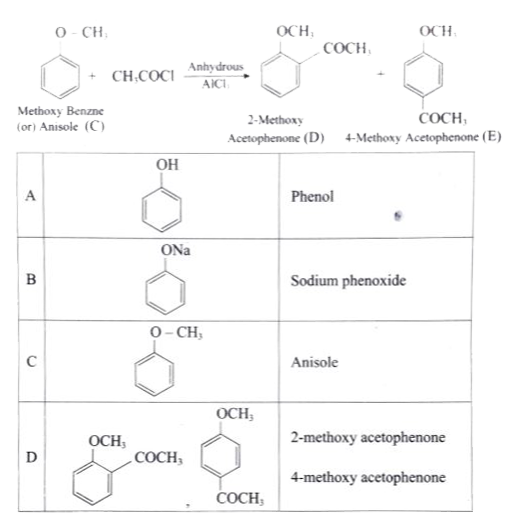An organic compound (A) of molecular formula C6H6O gives white precipitate with bromine water. (A) on reaction with NaOH gives (B). (B) reacts with methyl iodide in presence of dry ether gives (C) of molecular formula C7H8O which will not liberate H2 gas with metallic Na. (C) on reaction with acetyl chloride gives (D) and (E) of formula which are position isomers. Identify A, B, C, D & E and explain the reaction.
(i) An organic compound gives white precipitate with bromine water means it must be a phenol. From the molecular formula it is identified as C6H5OH.
(ii) Phenol on reaction with NaOH gives (B) as sodium phenox C6H5ONa.

(i) Sodium phenoxide on reaction with methyl iodide in the pressure of dry ether undergo Williamsons synthesis and gives Anisole as (C).

(iv) Anisole on reaction with acetyl chloride undergoes Friedel Craft.s acetylation and vicid o-methoxy acetophenone and p-methoxy acetophenone as (D) and (E).

Topper's Solved these Questions
- HYDROXY COMPOUNDS AND ETHERSBOOK - FULL MARKSCHAPTER - HYDROXY COMPOUNDS AND ETHERSEXERCISE - ADDITIONAL QUESTIONS (Assertion and reasons)
20 Videos
- ELECTRO CHEMISTRYBOOK - FULL MARKSCHAPTER - ELECTRO CHEMISTRYEXERCISE - ADDITIONAL QUESTIONS -5- MARK QUESTIONS
15 Videos
- IONIC EQUILIBRIUMBOOK - FULL MARKSCHAPTER - IONIC EQUILIBRIUMEXERCISE - ADDITIONAL QUESTIONS (5 MARK QUESTION)
15 Videos
Similar Questions
An organic compound P has molecular formula C2H4. On reduction, it gives another compound Q with molecular formula C2H6. Q reacts with chlorine in the presence of sunlight to give R having molecular formula C2H5Cl.
Identify P, Q and R.
View SolutionA compound C (molecular formula, C2H4O2) reacts with Na metal to form a compounds R and evolves a gas which burns with a pop sound. Compound C on treatment with an alcohol A in the presence of an acid form a sweet smelling compound S (molecular formula, C3H6O2). On addition of NaOH to C, it also gives R and water.S on treatment with NaOH solution gives back R and A.
Identify C,R,A,S and write down the reactions involved.
View Solution
Knowledge Check
An organic compound A of molecular formula C2H4, on reduction gives another compound B of molecular formula C2H6. B on reaction with chlorine in the presence of sunlight gives C of molecular formula C2H5CI .
The general formula for alkene is:ACnH2nBCnH2n+2CCnH2n−2DCnH2n+1An organic compound A of molecular formula C2H4, on reduction gives another compound B of molecular formula C2H6 .B on reaction with chlorine in the presence of sunlight gives C of molecular formula C2H5CI .
Which of these statements is correct regarding addition reaction?AAddition of hydrogen does not require catalyst.BMultiple bonds (double and triple bonds) must be present between carbon atoms in the chain of hydrocarbon.CMultiple bonds are not required for the reaction to take place.DNone of the above.An organic compound A of molecular formula C2H4, on reduction gives another compound B of molecular formula C2H6 .B on reaction with chlorine in the presence of sunlight gives C of molecular formula C2H5CI .
The compounds A, B and Care:AA: ethene B: ethane C: chloroethaneBA: ethane B: ethyne C: chloromethaneCA: ethyne B: ethane C: chloroethaneDA: ethene B: ethyne C: chloroethane
An aliphatic compound (A) with a molecular formula C3H6O reacts with phenylhydrazine to give compound (B). Reaction of (A) with I2 in alkaline solution on warming gives a yellow precipitate (C). Identify the compounds A, B and C.
View SolutionA compound C (molecular formula, C2H4O2) reacts with Na metal to form a compounds R and evolves a gas which burns with a pop sound. Compound C on treatment with an alcohol A in the presence of an acid form a sweet smelling compound S (molecular formula, C3H6O2). On addition of NaOH to C, it also gives R and water.S on treatment with NaOH solution gives back R and A.
Identify C,R,A,S and write down the reactions involved.
View SolutionAn organic compound A’ with molecular formula C7H7NO reacts with Br2/aqKOH to give compound B’, which upon reaction with NaNO2&HCl at O∘C gives C’. Compound C’ on heating with CH3CH2OH gives a hydrocarbon D’. Compound B’ on further reaction with Br2 water gives white precipitate of compound E’. Identify the compound A, B, C, D&E, also justify your answer by giving relevant chemical equations.
View SolutionAn organic compound A of molecular formula C2H4, on reduction gives another compound B of molecular formula C2H6 .B on reaction with chlorine in the presence of sunlight gives C of molecular formula C2H5CI .
Unsaturated hydrocarbons undergo________ reaction
View SolutionAn organic compound A of molecular formula C2H4, on reduction gives another compound B of molecular formula C2H6 .B on reaction with chlorine in the presence of sunlight gives C of molecular formula C2H5CI .
Choose the correct condition for conversion of ethene to ethane:
View Solution
